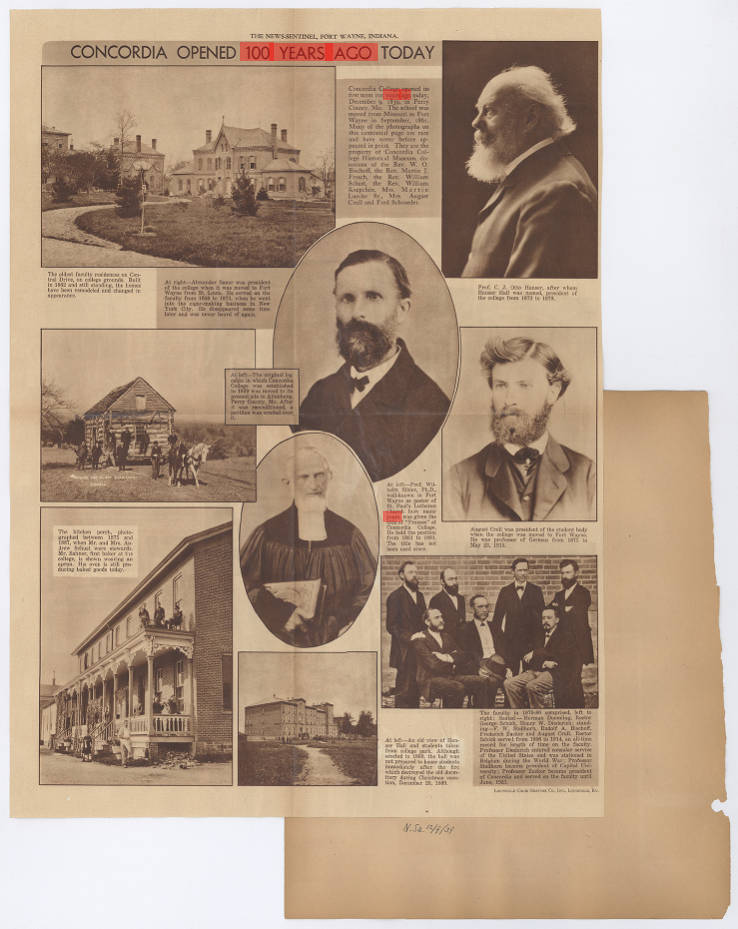Saturday, October 25, 2025 post by Friends of Wyneken on Facebook:
On October 12, the Friends of Wyneken hosted a presentation on the American Luther League (based in Fort Wayne) and the Lutheran purchase of Valparaiso University. This article, which appeared in the Fort Wayne Lutheran earlier this month, provides a summary of the first half of the presentation.
Friday, October 24, 2025 post by The Fort Wayne Lutheran
The American Luther League: How FW Lutherans overcame adversity a century ago
This is part one of a two-part series about the history of the American Luther League written by Nathan Bienz, a Fort Wayne Lutheran board member. Part two will appear in the November issue.
World War I brought with it a wave of anti-German hysteria that strongly impacted Lutherans in the Fort Wayne area. Churches were spied on, farmers threatened, and in one memorable case, a nearby school was dynamited (at Zion, Schumm, near Van Wert, OH). After the war’s end, the Indiana legislature voted nearly unanimously to ban the German language in all elementary schools in the state, with the governor signing the bill into law on February 25, 1919.
Lutherans across the state were divided in their opinion of the new law, with the loudest opposition coming from Allen and Adams counties.
These opponents became even more concerned by the efforts of Freemasons and others to ban private schools entirely. A group of prominent laymen from Fort Wayne, frustrated with what they perceived as district and synodical officials’ lackluster leadership, resolved to organize themselves in defense of the parochial schools. They decided to establish a city-wide chapter of the recently-organized Lutheran Laymen’s League (LLL), gaining almost 2,000 members at their inaugural meeting on March 24, 1919. Such a pan-congregational structure violated the bylaws of the LLL, however, leading to friction with the national LLL leadership. By August of 1919, the Fort Wayne group decided to strike out on their own, forming a new organization called the American Luther League (ALL).
A fierce rivalry soon sprang up between the two leagues, exacerbated by the ALL’s decision to charge dramatically lower annual dues than the LLL.
Synodical officials described the ALL as “dangerous” and “parasites,” and the synod president privately wrote that he hoped the organization would die a quick death.
In response, the ALL banned all pastors and teachers from becoming members, though they soon hired the energetic Rev. John C. Baur, pastor of Trinity, Decatur Rd., to be their full-time Field Secretary.
Under the leadership of Secretary Baur and board chairman Dr. H. A. Duemling, the ALL quickly spread throughout the country, gaining 32,000 members within two years.
In all of its activities, the ALL moved very quickly. It started a monthly magazine - the Lutheran Layman (later taken over by the LLL) - and began publishing a series of pamphlets within only a few months of its founding.
In June of 1920, the league resolved to raise $25,000 to help Concordia College, Fort Wayne (located where Indiana Tech now is), expand its library and purchase new lab equipment.
In 1922, the ALL purchased a house for the new Purdue University Concordia Club, the forerunner of today’s Beta chapter of Beta Sigma Psi.
The league also helped hundreds of congregations strengthen or reopen their schools and provided fellowship opportunities for tens of thousands of Lutherans across the country.
The ALL’s primary focus, however, was its ceaseless struggle against the opponents of parochial schools. The 1920s saw the rise of the Ku Klux Klan across the country, and especially in Indiana, with almost a third of the adult male population of the state joining between 1920 and 1925. The Klan fiercely attacked parochial schools, deriding them as un-American and a threat to democracy.
The Freemasons also organized to suppress parochial schools, especially in the southern states. At the same time, many leading educators began to push Bible reading, prayer, and religious instruction in the public schools, which the leaders of the LCMS and the ALL strongly opposed.
In 1920, the ALL poured tireless efforts into defeating a Michigan referendum that would require all students to attend public schools.
After that referendum was defeated, the organization pivoted swiftly to Oregon, where the Masonic Lodge and the KKK campaigned in favor of a similar referendum.
ALL Field Secretary Baur spent much of 1922 stumping throughout the state, making occasional additional trips to Kansas and Oklahoma to fight against similar proposals there.
In the end, the Oregon Compulsory Education Act passed by a vote of 115,506 to 103,685. The law was swiftly challenged in court, and on June 1, 1925, the Supreme Court ruled in Pierce v. Society of Sisters that states may not require students to attend public schools, holding instead that parents are primarily responsible for their children’s education.
With this victory, the main purpose of the ALL was accomplished. Its national leadership, still based in Fort Wayne, set their eyes on a new goal: the establishment of a new Lutheran university.
Part two of this two-part series, coming in the November issue, will tell the story of the ALL and the purchase of Valparaiso University.
This image comes from the Harter Postcard Collection in our Community Album.

